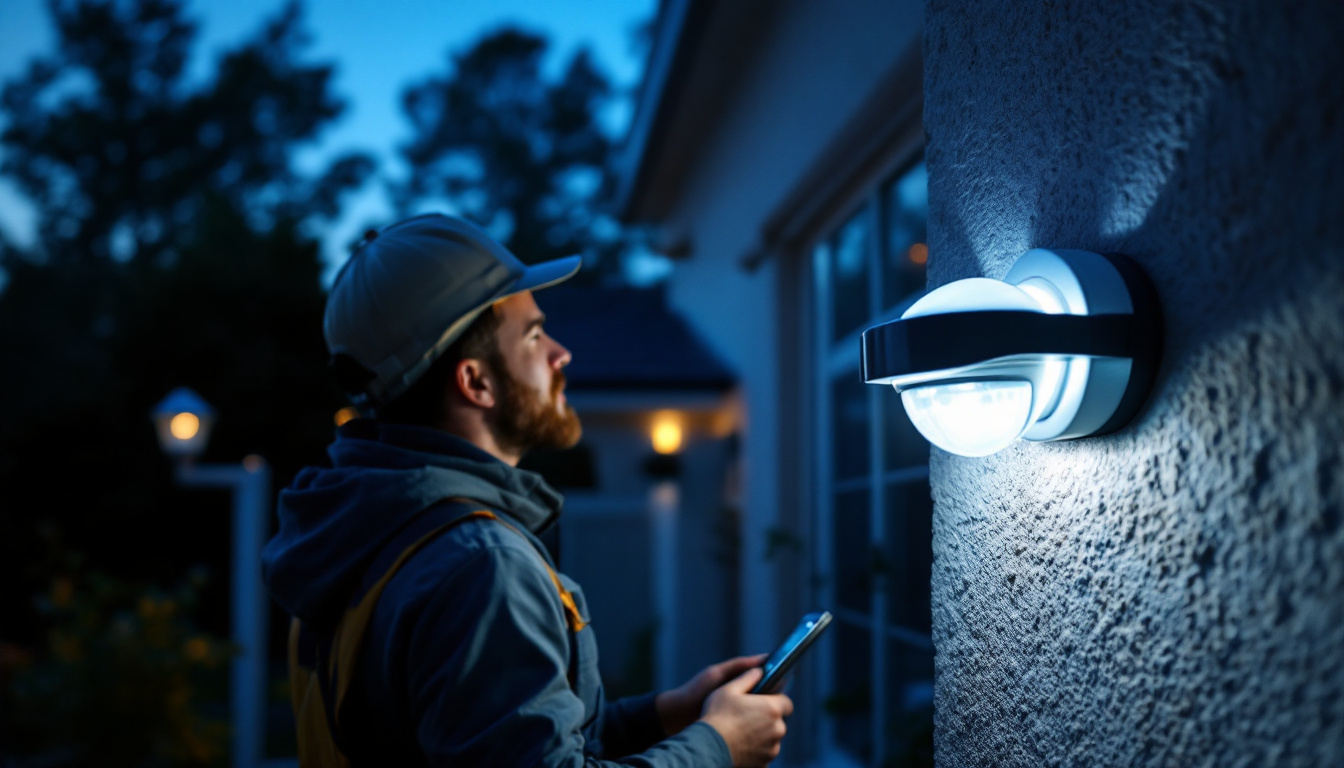
In the ever-evolving landscape of security technology, motion sensing security lights have emerged as a crucial component for both residential and commercial properties. These lights not only enhance safety but also provide energy efficiency and convenience. For lighting contractors, understanding the intricacies of motion sensing technology is essential for delivering optimal solutions to clients.
This article aims to equip lighting contractors with essential tips and insights into motion sensing security lights. By mastering the nuances of installation, selection, and maintenance, contractors can elevate their service offerings and meet the growing demand for smart lighting solutions.
Motion sensing security lights operate using advanced technology that detects movement within a specified range. This capability not only helps in illuminating dark areas but also acts as a deterrent to potential intruders. Many models come equipped with adjustable sensitivity settings, allowing users to customize how they respond to movement, whether it be from a person, animal, or even passing vehicles. This flexibility is particularly beneficial in residential settings, where homeowners may want to avoid false alarms triggered by pets or wildlife while still ensuring robust security during the night.
Moreover, the integration of smart technology has revolutionized motion sensing lights, allowing them to be connected to home automation systems. This means that users can control their security lights remotely via smartphone apps, receive alerts when motion is detected, and even integrate them with other smart devices such as security cameras and alarms. For lighting contractors, understanding these advanced features is vital for recommending the right products to clients, ensuring they receive a comprehensive security solution that not only meets their immediate needs but also adapts to future technological advancements.
Before diving into installation techniques and product recommendations, it’s vital for contractors to grasp the underlying technology behind motion sensing lights. These devices utilize sensors to detect movement within a specified range, triggering the light to activate. The two most common types of sensors used in these lights are passive infrared (PIR) sensors and microwave sensors.
PIR sensors detect changes in infrared radiation, which is emitted by moving objects, particularly warm bodies like humans and animals. These sensors are widely used due to their cost-effectiveness and reliability. They are ideal for outdoor applications, where they can cover a significant area and respond promptly to intrusions.
However, contractors should be aware of the limitations of PIR sensors. They may not detect motion through solid objects, such as walls or fences, and their sensitivity can be affected by environmental factors like temperature and humidity. Additionally, the placement of PIR sensors is crucial; if they are installed too low or in areas with frequent temperature fluctuations, such as near air conditioning units, their effectiveness can be compromised. Understanding the optimal installation height and angle can significantly enhance their performance.
Microwave sensors, on the other hand, emit microwave pulses and measure the reflection off moving objects. These sensors can detect motion through walls and other obstacles, making them more versatile than PIR sensors. They are particularly useful in larger areas or where the layout may obstruct the line of sight.
Despite their advantages, microwave sensors tend to be more expensive and may have a higher false alarm rate due to their sensitivity. They can be triggered by small movements, such as a tree branch swaying in the wind, which can lead to unnecessary activations. Contractors must consider the specific environment where these sensors will be installed, as factors like nearby vegetation or fluctuating weather conditions can impact their reliability. Furthermore, the ability to adjust the sensitivity settings on many microwave sensors allows for fine-tuning, ensuring that they respond appropriately to genuine movement while minimizing false alarms.
Selecting the appropriate motion sensing security light involves considering various factors, including the environment, the specific needs of the client, and the features of the light itself. Here are some key considerations for lighting contractors:
The installation location plays a critical role in the effectiveness of motion sensing lights. Outdoor lights should be weather-resistant and capable of withstanding various environmental conditions. Additionally, the range of the sensor and the angle of detection should be assessed based on the layout of the property.
For example, areas with high foot traffic may require lights with a broader detection range, while secluded areas may benefit from lights with adjustable sensitivity settings. Contractors should also consider the height at which the lights will be installed, as this can significantly affect their performance.
Another important factor is the light output. Contractors should recommend lights with adequate lumens to ensure visibility and security without being overly bright, which could lead to light pollution or disturb neighbors. Energy-efficient options, such as LED lights, are increasingly popular due to their longevity and lower energy consumption.
Incorporating smart technology features, such as dimming capabilities and integration with home automation systems, can also enhance the appeal of motion sensing security lights. These features allow clients to customize their lighting experience while maximizing energy savings.
Proper installation is crucial for the effectiveness of motion sensing security lights. Lighting contractors should follow best practices to ensure that the lights function optimally while providing maximum security. Here are some essential tips for installation:
Sensor placement is one of the most critical aspects of installation. Contractors should install sensors at a height that allows for optimal detection while minimizing the risk of false alarms. Typically, a height of 6 to 8 feet is recommended for PIR sensors, while microwave sensors can be installed higher due to their ability to detect motion through obstacles.
Additionally, the angle of the sensor should be adjusted to cover the desired area effectively. Contractors should conduct a walk-through of the property to identify potential blind spots and ensure that the sensors are positioned to cover these areas adequately.
After installation, testing and calibration are essential steps to ensure that the motion sensing lights function as intended. Contractors should walk through the detection area to verify that the lights activate promptly and that the sensitivity settings are appropriate for the environment.
Adjustments may be necessary to fine-tune the sensor’s sensitivity and detection range. This process not only enhances the performance of the lights but also instills confidence in clients regarding the effectiveness of their security system.
Encourage clients to conduct regular inspections of their motion sensing lights. This includes checking for any obstructions that may hinder the sensor’s performance, such as dirt, debris, or overgrown vegetation. Additionally, clients should inspect the lights for signs of wear or damage, such as flickering bulbs or corroded connections.
Contractors can provide a maintenance checklist to clients, outlining specific tasks to perform and the frequency of inspections. This proactive approach can help prevent issues before they arise and ensure that the security lights remain functional.
Despite proper installation and maintenance, issues may occasionally arise with motion sensing security lights. Contractors should be prepared to troubleshoot common problems that clients may encounter. For instance, if the lights are not activating, it could be due to a misaligned sensor, low battery (for battery-operated models), or obstructions blocking the sensor’s view.
Additionally, if the lights are activating too frequently, it may be necessary to adjust the sensitivity settings or reposition the sensor to avoid detecting non-threatening movements, such as passing animals or tree branches swaying in the wind.
Lighting contractors play a vital role in educating clients about the features and benefits of motion sensing security lights. By providing comprehensive information, contractors can help clients make informed decisions and appreciate the value of their investment. Here are some key points to emphasize:
One of the primary benefits of motion sensing security lights is their ability to enhance security. By illuminating areas when movement is detected, these lights deter potential intruders and provide a sense of safety for homeowners and businesses alike. Contractors should highlight the psychological impact of well-lit spaces, as they can discourage criminal activity.
Another significant advantage is the energy efficiency of motion sensing lights. Unlike traditional lighting systems that remain on continuously, motion sensing lights only activate when needed, resulting in lower energy consumption and reduced utility bills. Educating clients about these cost savings can be a compelling selling point for contractors.
Motion sensing security lights are an invaluable addition to any security system, offering both safety and energy efficiency. For lighting contractors, mastering the intricacies of these devices is essential for providing top-notch service and meeting the evolving needs of clients.
By understanding the technology, selecting the right products, adhering to best installation practices, and offering ongoing maintenance, contractors can position themselves as experts in the field. Educating clients about the features and benefits of motion sensing security lights will further enhance their experience and satisfaction.
In a world where security is paramount, lighting contractors have the opportunity to make a significant impact by delivering innovative and effective lighting solutions. Embracing the potential of motion sensing technology can lead to a brighter, safer future for clients and communities alike.
Ready to elevate your lighting projects with the best motion sensing security lights on the market? Look no further than LumenWholesale, where we provide contractors with superior, spec-grade lighting solutions at unbeatable wholesale prices. Say goodbye to local distributor markups and hello to our extensive selection of high-performance lighting that meets the highest industry standards. Plus, with free shipping on bulk orders, you can stock up on premium lighting without any hidden fees or compromises. Enhance your service offerings with quality, affordability, and convenience. Visit LumenWholesale now and discover the value we bring to your projects!

Discover the ultimate guide to light switches with expert insights tailored for lighting contractors.

Discover how innovative bakery fixtures can provide lighting contractors with a competitive edge.

Discover why MR16 LED bulbs are a game-changer for lighting contractors.

Discover innovative hacks for smart lighting contractors to transform your home office into a well-lit, productive haven.